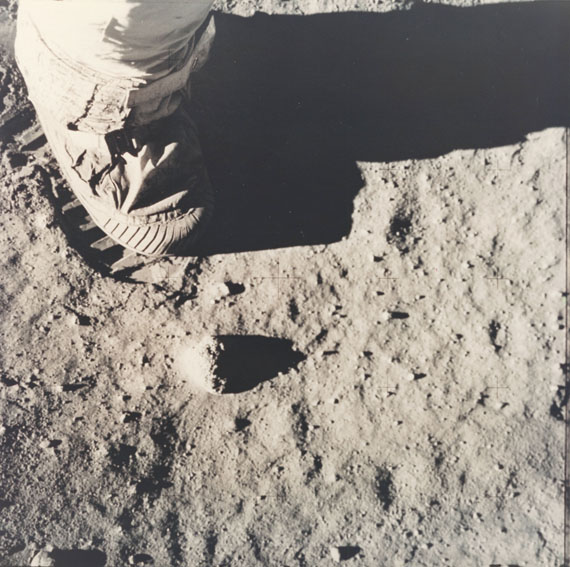
Apollo 11 Mission : Edwin E. (Buzz) Aldrin, Jr's boot print on the lunar surface, July 20th, 1969
Vintage color print on lightly resin-coated Kodak paper.
"A Kodak Paper" watermark on verso
Image : 19,3 x 19,3 cm, Sheet : 20,2 x 20,2 cm
Magnificent Desolation
Trésors photographiques de la NASA
Exhibition: 31 Jan – 31 Mar 2015
Galerie Catherine et André Hug
2, rue d l'Echaudé
75006 Paris
Wed-Sat 11-13, 14:30-19
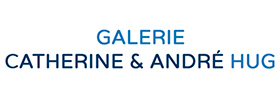
Galerie Catherine & André Hug
40, rue de Seine / 2, rue d l'Echaudé
75006 Paris
+33(0)6-07134800
c.hug@orange.fr
www.galeriehug.com
Wed-Sat 11-13, 14:30-19
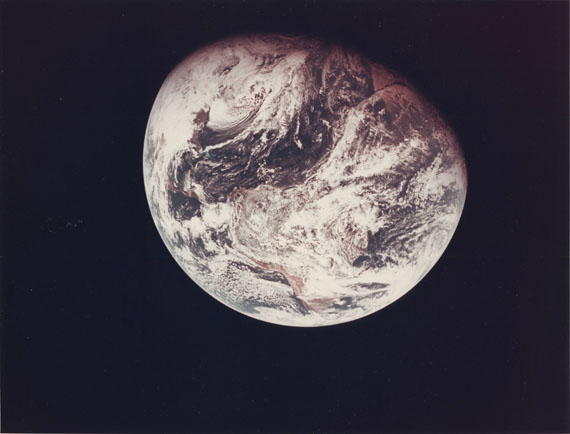
Apollo 8 Mission : One of the first whole views of Earth recorded by an astronaut, December 21st, 1968
Vintage color print on fiber-based Kodak paper.
NASA serial number "NASA AS8-16-2593"in red ink in upper margin. Typewritten caption in purple ink
"A Kodak Paper" watermark on verso.
Image : 18,3 x 18,1 cm, Sheet : 20,4 x 25,5 cm
Christophe Lunn and Catherine & André Hug present
"MAGNIFICENT DESOLATION"
Exhibition extended through March 31st, 2015
On July 20th, 1969, astronauts Neil Armstrong, pilot of the lunar module "Eagle", and Edwin E. (Buzz) Aldrin Jr., landed on the lunar surface, in a zone called Sea of Tranquility. When Aldrin joined Armstrong on the ground, he was in awe :
Buzz Aldrin : Beautiful. Beautiful.
Neil Armstrong : Isn't that something? Magnificent sight down here. (Pause)
Buzz Aldrin : Magnificent desolation. (Long silence)
In only seven years, NASA scientists, technicians and astronauts fulfilled President John F. Kennedy's 1962 promise to send a man to the moon before the end of the decade.
The technological and human challenges undertaken by the space adventure stimulated innovation in a number of scientific and industrial fields, including photography.
In 1962, astronaut Wally Shirra took his Hasselblad 500c camera and 80mm Zeiss lens on board the Mercury-Atlas 8 mission and brought back the first recognizable images of Earth. The same camera, equipped with a modified back to contain 100 frames, was borrowed by Gordon Cooper on Mercury-Atlas 9.
Following this, Hasselblad, who provided NASA with cameras, and Kodak, who made the negative film stock and paper for prints, mobilized their teams and research departments to improve the astronauts' equipment. The astronauts themselves were trained to photograph in extreme light conditions in order to master frame, aperture settings, and color filters used in topographical photography.
The Mercury, Gemini and Apollo missions impacted the design and functions of cameras, lenses and various materials (film and paper), leading to important commercial breakthroughs for the companies involved. The astronauts' "souvenir" photographs, disseminated by NASA and published in color in newspapers and magazines worldwide, forever changed the public perception of the solar system and our planet.
These vintage color prints, photographs of extraordinary travels, historical documents, exceptional objects, which have withstood the test of time and exposure to light, refer to man's ultimate dream, the millenial quest : taming the sky. Beyond the anecdotic or the nostalgic, certain images have become iconic, timeless : Ed White, connected to his spaceship by an umbilical cord; Earth, a blue gem, receding from Apollo 8's porthole; Aldrin's boot print on the lunar surface...
These photographs speak to every generation. In the end, what do we seek among the stars? Our origins? Proof that we are not alone? Is there an other world?
The moon is perhaps a mirror. In seeking to attain it, humanity understood at least one thing : That Earth is the most precious of spaceships.�
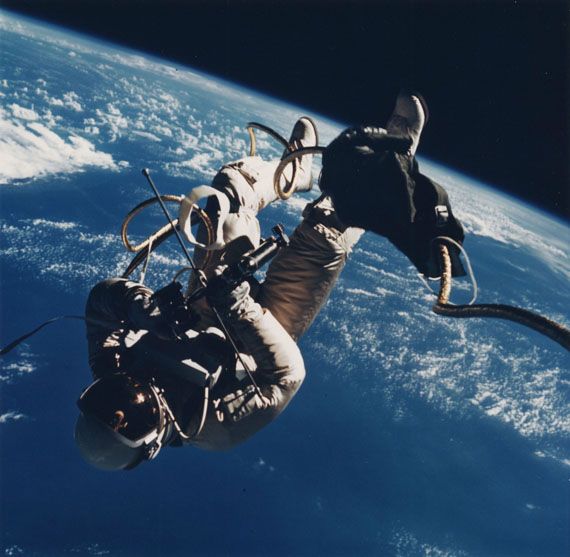
Gemini 4 Mission : Astronaut Edward H. White II, the first american spaceqalk, above the Gulf of Mexico, June 3rd, 1965
Vintage color print on fiber-based Kodak paper.
NASA serial number "NASA S-65-30432" in red ink in upper margin. Typewritten caption in purple ink
"A Kodak Paper"watermark on verso.
Image : 18,3 x 18,1 cm, Sheet : 20,4 x 25,5 cm
Christophe Lunn et Catherine & André Hug présentent
"MAGNIFICENT DESOLATION"
Exposition prolongé jusqu'au 31 mars 2015
Le 20 juillet 1969, les astronautes américains Neil Armstrong, pilote du module lunaire "Eagle", et Edwin E. (Buzz) Aldrin, Jr, se posent sur la surface de la lune, dans une zone appelée Mer de tranquillité. Lorsqu'Aldrin rejoint Armstrong sur le sol, il s'extasie :
Buzz Aldrin : Beautiful. Beautiful.
Neil Armstrong : Isn't that something? Magnificent sight down here. (Pause)
Buzz Aldrin : Magnificent desolation. (Long silence)
En seulement sept ans, les scientifiques, techniciens et astronautes de la NASA remplissent la promesse faite par le Président John F. Kennedy en 1962, d'envoyer un homme sur la lune avant la fin de la décennie.
Les défis technologiques et humains soulevés par cette aventure spatiale stimulent l'innovation dans de nombreux secteurs scientifiques et industriels, dont celui de la photographie.
En 1962, l'astronaute Wally Shirra embarque un boitier Hasselblad 500c muni d'un objectif Zeiss 80 mm sur la mission Mercury-Atlas 8. Il réalise alors les premières photos reconnaissables de la Terre. Ce même boitier, dont le chargeur a été modifié pour contenir 100 vues, sera emprunté par Gordon Cooper lors de la mission Mercury-Atlas 9.
Par la suite, les sociétés Hasselblad, qui fourni les boitiers à la NASA, et Kodak, qui fabrique les pellicules et le papier pour les tirages, mobilisent leurs équipes de recherche pour perfectionner le matériel utilisé par les astronautes. Ceux-ci sont formés aux prises de vue dans les conditions de lumière extrêmes de l'espace, afin de maitriser le cadrage, l'ouverture du diaphragme, et les filtres couleurs employés pour la photographie topographique.
Les missions Mercury, Gemini et Apollo, impactent la fabrication des boitiers, des objectifs et des différents supports (films et papier) ce qui entrainera des retombées commerciales importantes pour les marques impliqués. Les photos "souvenirs" des astronautes, diffusées par la NASA et publiées en couleur dans les journaux et revues à travers le monde, changent à jamais la perception publique du système solaire et de notre planète.
Ces tirages couleur d'époque, photographies de voyages hors du commun, documents historiques, objets extraordinaires, qui ont survécus au temps, à la lumière, renvoient au rêve ultime de l'homme, la quête millénaire : celle de dompter le ciel. Au delà de l'anecdotique ou du nostalgique, certains clichés sont devenus iconiques, intemporels : Ed White, rattaché à son vaisseau par un cordon ombilical, flottant dans l'espace au dessus du Nouveau Mexique; La Terre, une agate bleue, qui s'éloigne du hublot d'Apollo 8; la trace de la botte d'Aldrin sur la surface lunaire...
Ces photographies s'adressent à toutes les générations. Au fond, que cherchons nous parmi les étoiles? Nos origines? La preuve que nous ne sommes pas seuls? Y a t'il un ailleurs?
La lune est peut être un miroir. En cherchant à l'atteindre, l'humanité a au moins compris une chose : Que la Terre est le plus précieux des vaisseaux.�
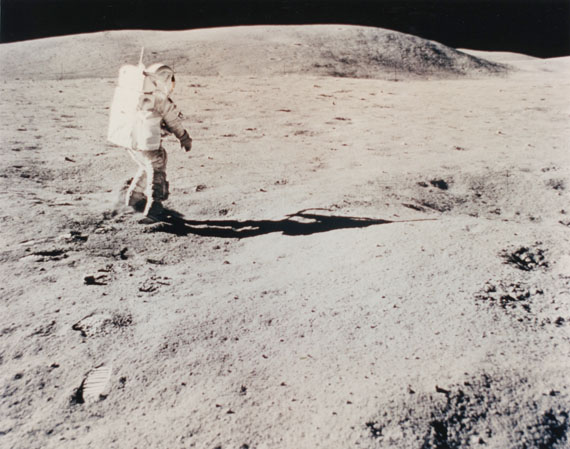
Apollo 16 Mission : The astronaut Charles M. Duke Jr., pilot of the lunar module, near Plum Crater, during the first EVA, April 21st, 1972
Vintage color print on resin-based paper. Typewritten caption in purple ink
"A Kodak Paper" watermark on verso.
Image : 19,3 x 24,4 cm, Sheet : 20,2 x 25,5 cm